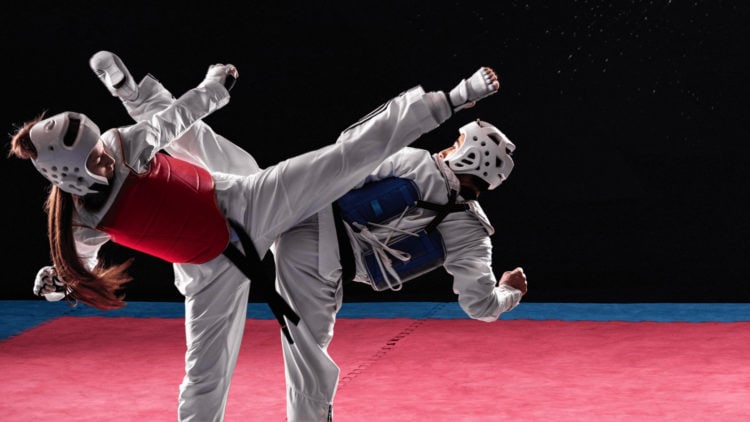
OBJECTIVE OF OLYMPIC TAEKWONDO: Score more points than the opponent by delivering solid punches and kicks to the opponent’s upper body.
NUMBER OF PLAYERS: 2+ players
MATERIALS: A dobok (uniform), head protector, mouth guard, chest protector, arm guards, hand guards, shin guards, groin protection
TYPE OF GAME: Sport
AUDIENCE: 4+
OVERVIEW OF OLYMPIC TAEKWONDO
Olympic Taekwondo is a martial art focused on respect, discipline, and, of course, violent kicks and punches! This sport pits two competitors against each other in a ring, each attempting to score points by making appropriate contact with the opponent’s torso and head.
SETUP

EQUIPMENT
Due to the physical nature of the sport, Olympic Taekwondo often requires the following protective gear to be worn:
- Head protector
- Chest protector
- Mouthguard
- Armguards
- Handguards
- Shinguards
- Groin protection
Additionally, competitors often wear a traditional Korean uniform known as a “dobok”.
Depending on the competition, the head and chest protectors often contain electronic sensors that record when contact is made and how forceful the punch or kick was, two crucial factors of the scoring system.
COMPETITION RING
Olympic Taekwondo competitors spar in an octagon-shaped ring that measures 26 feet in diameter. Athletes must retain at least one foot within the octagon at all times. Otherwise, they’re open for disqualification.
GAMEPLAY

Like other martial arts, Olympic Taekwondo pits one competitor against another in a technique-focused fight. This physical struggle consists of three rounds that last two minutes each, usually with only a minute break between rounds.
SCORING
To score points, punches and kicks must be administered above the waist. Any contact made below the waist, including to the opponent’s legs when in the air, can result in a penalty. Further, punches to the head are not allowed.
A simplification of Olympic Taekwondo scoring is as follows:
- 1 point for a punch to the chest
- 2 points for a kick to the chest
- 3 points for a kick to the head
- 4 points for a spinning kick to the chest
- 5 points for a spinning kick to the head
If a player is penalized, their opponent is awarded 1 point for each infraction.
For a punch to be deemed valid, it must be done with a “straight punch” technique. Similarly, a kick is only valid if the contact occurs at the foot (below the ankle).
PENALTIES
Penalties are called by the referee, whose main task is to ensure the round’s action continues. Similar to boxing, this mainly involves separating fighters when they start hugging each other in defense, which disallows either competitor from punching or kicking. Otherwise, referees are looking to penalize athletes for the following infractions:
- Kicking or punching the opponent below their waist
- Kneeing the opponent
- Punches to the face
- Fully stepping out of the sparring octagon
- Excessively pushing/grappling with the opponent
All of these penalties result in one point given to the non-offender.
END OF GAME
After the third and final two-minute round, the victor is the fighter who has accumulated the most points. In the case of a tie, a “Golden Point Round” ensues, with the winner being the first competitor to score a point.
Additionally, a match can end in a knockout, which is relatively common considering the frequency of kicks to the head.
- 30 GAMES TO PLAY OVER TEXT - April 22, 2024
- 20+ FREE PRINTABLE BABY SHOWER GAMES - April 16, 2024
- 20+ College Party Games for the Best Night Ever! - April 2, 2024